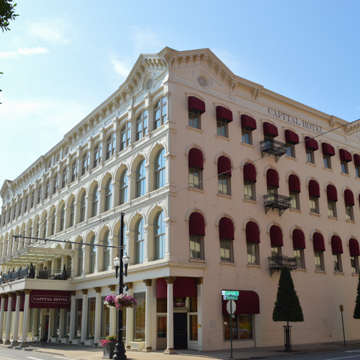Although it has operated as a hotel almost continuously since 1877, for its first five years the building housed stores and offices. It was named after William P. Denckla, one of the builders of the Little Rock and Fort Smith Railroad and owner of several buildings on the block. The most striking feature of the building is its Italianate cast-iron facade, manufactured in New York and shipped in pieces to Little Rock. Initially, the building was three stories tall but due to the hotel’s tremendous popularity, a fourth story, also clad in cast iron, was added around 1890. Through the early twentieth century the Capital Hotel was the best hotel in the city and hosted President Ulysses Grant on his 1880 visit to Little Rock, but its popularity faded, and it closed in the late 1970s. A renovation in 1983 included a new addition on the south side to increase the hotel’s capacity. The Capital Hotel has returned to its place as one of the city’s top hotels. Former presidents Jimmy Carter and George H. W. Bush, among other notables, have been guests.
You are here
Capital Hotel (Denckla Block)
If SAH Archipedia has been useful to you, please consider supporting it.
SAH Archipedia tells the story of the United States through its buildings, landscapes, and cities. This freely available resource empowers the public with authoritative knowledge that deepens their understanding and appreciation of the built environment. But the Society of Architectural Historians, which created SAH Archipedia with University of Virginia Press, needs your support to maintain the high-caliber research, writing, photography, cartography, editing, design, and programming that make SAH Archipedia a trusted online resource available to all who value the history of place, heritage tourism, and learning.







